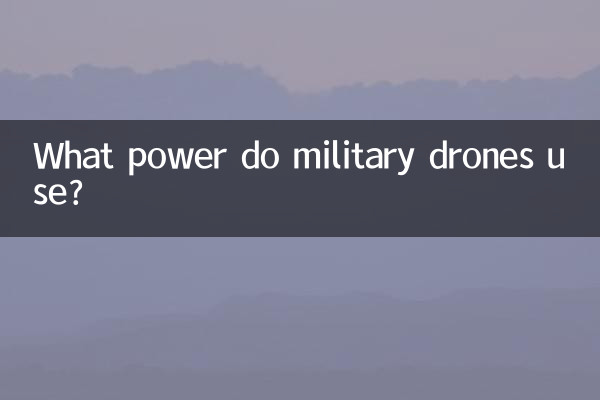What powers military drones: a combination of technical analysis and hot topics
In recent years, military drones have played an increasingly important role in battlefield reconnaissance, precision strikes and other fields, and the choice of their power system is directly related to the endurance, speed and concealment of the drone. This article combines the hot topics on the Internet in the past 10 days to conduct a structured analysis of the power types and technical characteristics of military drones.
1. Power types of military drones

The power systems of military UAVs are mainly divided into the following categories, each type has its own advantages and disadvantages:
| Power type | Technical features | Representative models | Applicable scenarios |
|---|---|---|---|
| Fuel engine | Long battery life and high power, but obvious noise and heat signature | MQ-9 "Reaper" | Long-endurance reconnaissance, ground attack |
| electric motor | Quiet and concealable, but limited battery life | RQ-11 "Raven" | Short-range reconnaissance, special operations |
| hybrid | Combines the advantages of fuel and electric power, but has a complex structure | "Predator" Type C | Flexible deployment of multiple tasks |
| solar power | Infinite battery life, but weather dependent and low power | Zephyr Drone | High-altitude long-endurance surveillance |
2. Recent hot topics related to power technology
In the past 10 days, the following hot topics have been closely related to military drone power technology:
1.Drone applications in the Russia-Ukraine conflict: Ukraine uses Turkish TB2 drones (fuel-powered) to frequently attack Russian military logistics, triggering discussions on the battlefield survivability of small and medium-sized fuel-powered drones.
2.China's "Pterosaur-3" unveiled: This model uses a hybrid power system and has a battery life of 40 hours, making it a hotly discussed "long-range benchmark."
3.US "high-altitude pseudolite" test: The solar-powered drone "Odysseus" completed six months of continuous flight, promoting attention to near-space drones.
3. Development trends of power technology
| Technical direction | R&D progress | challenge |
|---|---|---|
| hydrogen fuel cell | In the US "Grey Eagle" extended-range test, the battery life increased by 50% | Hydrogen storage safety and cost |
| wireless charging | Israel develops battlefield fast charging system | Transmission efficiency, electromagnetic concealment |
| nuclear power | Russia announces microreactor plan | Radiation protection, international regulations |
4. Power comparison of main models in various countries
| nation | model | Power type | Maximum battery life |
|---|---|---|---|
| USA | MQ-9B | turbodiesel engine | 40 hours |
| China | Attack -11 | turbofan engine | 6 hours |
| Türkiye | TB2 | piston engine | 27 hours |
| Israel | "Heron" TP | turboprop | 36 hours |
5. Future Outlook
With the development of artificial intelligence and new energy technology, military drone power systems will show three major trends:(1) Multi-energy integration(such as solar energy + hydrogen energy),(2) Intelligent energy management(dynamically adjust output based on tasks),(3) Stealth design(Reduced infrared/acoustic signature). The recent case of Ukraine using "suicide drones" to attack the Russian hinterland shows that small and medium-sized electric drones still have huge potential in low-cost asymmetric warfare.
This article uses structured data display and combined with the latest hot spot analysis to help readers comprehensively understand the current status and future of military drone power technology. It should be pointed out that power selection needs to weigh mission requirements, cost and technology maturity, and there is no “one-size-fits-all solution”.

check the details

check the details